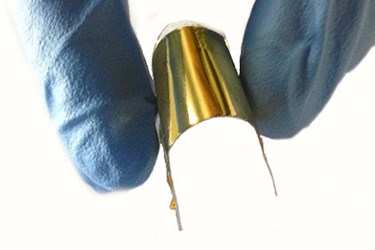Powering Wearable Sensors Through Skin-Generated Static Electricity

Scientists at the National University of Singapore (NUS) have developed a small and flexible device that could potentially harness energy from muscle movements, powering wearable sensors through everyday activities using static electricity.
The device converts mechanical energy of the muscles into electrical energy by using friction. The phenomenon is called the triboelectric effect, a type of contact electrification that occurs when two dissimilar substances rub together, creating friction and static when pulled apart or flexed. As the wearer moves, their skin rubs against the device, generating triboelectric power.
Chengkuo Lee, electrical and computer engineering professor at NUS, demonstrated at the recent International Conference on Micro Electro Mechanical Systems (MEMS) in Portugal that the device could generate 90 V of open circuit voltage by tapping it with his finger, reports IEEE Spectrum.
Using skin as one of the surfaces, scientists developed the second triboelectric surface using flexible silicone rubber molded into thousands of tiny pillars, which would rub up against the skin when the wearer moved. A 50-nm gold layer, bonded to the rubber, acts as the electrode that collects the resulting energy. The entire device is roughly the size of a postage stamp.
“Skin, the most abundant surface on the human body, is a natural choice for one of the triboelectric layers,” Lokesh Dhakar, a graduate student studying with Lee, explained in the IEEE Spectrum article. “Also skin as a triboelectric material has a high tendency to donate electrons or get positively charged which is important in improving the performance of the device if the other triboelectric layer intentionally chosen as the one with a tendency to get negatively charged.”
Furthermore, the rubber was molded into the pillar-shapes in order to increase surface area and thus increase the charge generated, Dhakar added.
NUS’s triboelectric nanogenerator is not the first of its kind. Researchers at Georgia Tech led by Zhong Lin Wang, a strong proponent of the triboelectric effect, developed a similar device in 2013 and published their early findings in ACS NANO. According to the study, their device can generate an open circuit voltage up to approximately 1000 V.
In comparison, the NUS finger tapping demonstration was enough to generate 90 V, or 0.8 mW of power, enough to power 12 LEDs. Further tests on the NUS device showed that fist clenching and speaking could generate between 7.3 and 7.5 V.
However, the Georgia Tech device is much larger and less flexible than the NUS device. Dhakar explained to IEEE Spectrum that his team’s primary objective was to find a more flexible material, which would allow for greater size versatility and more wearable options.
Image credit: National University of Singapore
